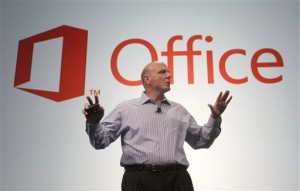
Microsoft CEO Steve Ballmer speaks at a Microsoft event in San Francisco on Monday, July 16, 2012. Microsoft unveiled a new version of its widely used, lucrative suite of word processing, spreadsheet and e-mail programs Monday, one designed specifically with tablet computers and Internet-based storage in mind. AP PHOTO/JEFF CHIU
SAN FRANCISCO, California—Software giant Microsoft previewed the newest version of its flagship Office application, which underwent its biggest refresh in more than a decade.
Sales of Office applications, which include programs like Word, Excel and PowerPoint, account for nearly a third of Microsoft’s sales.
Its newest version, Office 15, uses “cloud” technology to give users seamless access on different devices, be they desktops, laptops, tablet PCs or mobile phones.
The Office preview comes after the recent unveiling of Microsoft’s Surface tablet, the company’s answer to Apple’s market-leading iPad. Microsoft is also expected to launch its new Windows Phone 8 mobile platform in the coming months.
“Microsoft is revving up its entire product line in one year,” International Data Corp. (IDC) analyst Al Hilwa said at the sidelines of the preview. “Obviously, they understand that times have changed and that there are disruptive technologies out there.”
“There has been talk of Microsoft’s ‘lost decade,’ but they got the message and they have been working hard on the transformation,” he said.
Microsoft stopped short of announcing that the Office might eventually be made available on other mobile platforms. Officials declined to say whether Microsoft would release the new Office for non-Windows platforms like Google’s Android and Apple’s iOS for mobile devices.
Most smartphones sold today run on Google’s Android operating system, while Apple’s IPad, which runs on iOS, dominates the tablet market.
In his keynote, Microsoft CEO Steve Ballmer said the Office’s key feature, apart from being optimized for mobile devices, was that it would be offered primarily on a subscription basis—partially replacing the old software licensing model.
This means that Microsoft would veer away from its traditional way of making money, which is selling licenses for copies of its software. Instead, the company plans to charge customers for the use of its software, which is expected to make the applications more affordable.
Details on how the subscription service would work have yet to be announced, but Ballmer said “the new, modern Office will deliver unparalleled productivity and flexibility to customers.”
“It is a cloud service and will fully light up when paired with Windows 8,” Ballmer said.
Aside from the drastic change in Office’s user interface or “look and feel,” Ballmer said the new Office would tie in closely with SkyDrive, Microsoft’s “cloud” or the Internet storage service that would allow users to work on one device and pick up exactly where they left off on another without skipping a beat.
Another big change for the Office is the integration of social networking features, which will allow easier collaboration among several users.
A new application called OneNote, a new productivity tool for touch-screen devices, lets users “ink” in notes or scribbles on documents using a stylus.
Sales of the Microsoft Office contributed $22.2 billion to the company’s $70 billion revenue in 2011.